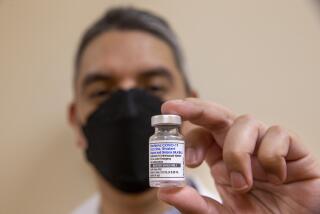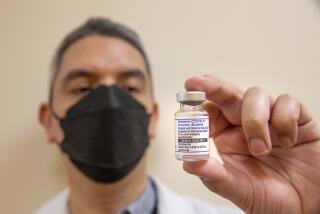COVID-19 surge fueled by unvaccinated children in U.K., a warning for California

Unvaccinated adolescents have been the driving force behind a stubbornly persistent Delta surge in Britain, a potential warning sign for California if inoculation rates don’t improve considerably among this age group, health experts warn.
Dr. George Rutherford, a UC San Francisco epidemiologist and infectious-disease expert, said unvaccinated 10- to 14-year-olds are driving the pandemic in the United Kingdom, with case rates among these ages significantly higher than any other group.
Rutherford was citing data from a New York Times analysis, which said that in mid-October, school-age children in England were 15 times as likely to be infected with the coronavirus as 80-year-olds. The analysis noted that England ended mandatory mask-wearing in mid-July, and officials did not recommend vaccinations for 12- to 15-year-olds until mid-September, four months after they were available for those ages in the U.S.
The U.K.’s surge in coronavirus cases has been uneven — climbing rapidly from mid-June to mid-July, then decreasing sharply before yo-yoing into a second peak in mid-October. There have been some signs of waning since the middle of last month, but cases remain well above the pre-Delta levels.
A lack of vaccinations among wide swaths of adolescents as COVID restrictions were lifted has resulted in the virus continuing to spread in the U.K., Rutherford said at a recent UC San Francisco campus forum.
“This is a consequence of failure to vaccinate. And the population that they failed to vaccinate are young adolescents,” Rutherford said. “This is being driven by younger adolescents largely, and they’ve just started a new campaign to vaccinate 12- to 15-year-olds. And only 21% of them are currently fully vaccinated.”
As Europe copes with a COVID surge, battle lines are forming between the vaccine-willing and vaccine-resistant. Sound familiar?
The urgency to vaccinate children comes as COVID-19 hospitalizations have started to increase in parts of California. Health officials have long expected that uptick as the weather cools and more people gather indoors.
“Unfortunately, what we were predicting, as people go indoors — that [hospitalization] rates may go up — was actually a reality,” said Dr. Regina Chinsio-Kwong, a deputy health officer in Orange County. “And even though we do have good vaccination rates, we need more people who are not yet vaccinated to get vaccinated.”
The U.K.’s challenges demonstrate how its overall vaccination efforts — while better than California’s — are still not high enough for herd immunity, when sustained coronavirus transmission is interrupted.
In the U.K., 67% of the population is fully vaccinated, according to Our World in Data; California has 62% of its population fully vaccinated. Across the U.S., that rate is 59%, according to the U.S. Centers for Disease Control and Prevention.
Children and teenagers have become major sources of coronavirus infection in Los Angeles and Orange counties.
Many parents eagerly hustled to schedule appointments this week after tens of millions of children nationwide became newly eligible for the COVID-19 vaccine. But surveys show that parents are divided on vaccinating kids ages 5 to 11.
Among all pediatric groups, children 5 to 11 began suffering the highest rate of new weekly coronavirus cases, displacing youths 12 to 17 as having the worst case rate, according to data released by the Los Angeles County Department of Public Health.
The change “is likely a consequence of increasing vaccination levels among teens and [previously] having no vaccinations available for those children 5 to 11,” county Public Health Director Barbara Ferrer told the Board of Supervisors just before vaccines became available to children in that age group.
But unvaccinated teenagers also have been big drivers of coronavirus transmission, L.A. County data show.
“The role of children in transmitting infection is very real. And the waves of infection that can result if children are not protected are, tragically, also very real,” Ferrer said recently.
Unvaccinated 12- to 17-year-olds have a coronavirus case rate about one-third higher than unvaccinated younger adults, a group that previously had the most coronavirus infections, according to L.A. County health data.
“Unvaccinated teens now have the highest case rate among all groups of all ages” who have long been eligible for vaccination, Ferrer said.
Only 65% of L.A. County youths 12 to 17 have been fully vaccinated. By contrast, 73% of L.A. County residents 16 and older are fully vaccinated, as are 86% of seniors 65 and up.
Orange County, where only 62% of 12- to 17-year-olds are vaccinated, is seeing similar trends. In the summer, older teens had the highest coronavirus case rates among those 18 and younger. Recently, children 4 to 9 have had higher case rates than the oldest teens, and had comparable case rates to middle-aged adults.
The statistics, Chinsio-Kwong said, show that vaccinations work, as immunizations among teenagers have helped reduce case rates. But they also show how essential it will be to reduce coronavirus transmission among children in order to fully emerge from the pandemic, experts said.
Many health officials — including Rutherford — have said that a substantial number of children will need to be vaccinated if communities are to achieve herd immunity against COVID-19.
The relatively large percentage of unvaccinated youths in Los Angeles County “is enough to sustain transmission,” Rutherford said. “And I think statewide, a lot of the increases we’re seeing are being driven numerically by cases in Los Angeles, which seem to be disproportionately falling into this age category.”
About half of kids 12 to 17 are fully vaccinated in the U.S., compared with nearly 70% of Americans 18 and older.
A stubbornly high level of transmission also presents the risk of spawning dangerous new variants, such as Delta, which fueled the latest wave in California.
“There’s always the potential for there to be a more devastating variant that takes hold. And we all lived through a terrible November, December and January last year,” Ferrer said during a recent briefing.
California’s coronavirus case rate is now higher than it was in a month ago, when the state was averaging about 5,500 new cases a day. Most recently, an average of about 6,300 new cases have been reported daily.
Statewide, the number of patients hospitalized with COVID-19 has plateaued over the last month, largely hovering between 3,500 and 3,800. That’s significantly less than the Delta peak on Aug. 31 of nearly 8,400 people hospitalized but still substantially higher than the pre-Delta low of 915 hospitalizations on June 12.
There is still hope that some areas might avoid a terrible winter surge, and rates will remain stable or could possibly decline. “But it requires everybody in our community to really be cautious and careful,” Chinsio-Kwong said.
Health officials say that, contrary to earlier in the pandemic when adults were the major spreaders of the virus, it’s now known that children can be effective spreaders of the coronavirus, especially with the emergence of the Delta variant.
Chinsio-Kwong said children can be infected and show no symptoms yet still transmit the virus, which can be problematic to family and friends “because you can expose everyone in your household without knowing it.”
“So they do have the potential to transmit it to a grandparent who may be at higher risk or to an immunocompromised family member,” she said. Gathering safely “does require everyone to get vaccinated if they are eligible,” she added.
Unvaccinated people are particularly at high risk for becoming super-spreaders because when they are infected, they shed far higher amounts of virus than those who are vaccinated and suffer breakthrough infections, she said.
Unvaccinated Californians are roughly seven times more likely to contract COVID-19, 10 times likelier to end up in the hospital and 17 times more likely to die from the disease than their vaccinated counterparts, state data show.
Although children are at low risk of severe illness or death from COVID-19 compared with adults, the disease still has become a leading cause of death nationwide. For the 12-month period ending Oct. 2, 66 children ages 5 to 11 died from COVID-19, a number that — when compared to the leading causes of death in children in 2019 — makes the virus the eighth leading cause of death in children of this age group.
More to Read
Start your day right
Sign up for Essential California for news, features and recommendations from the L.A. Times and beyond in your inbox six days a week.
You may occasionally receive promotional content from the Los Angeles Times.












